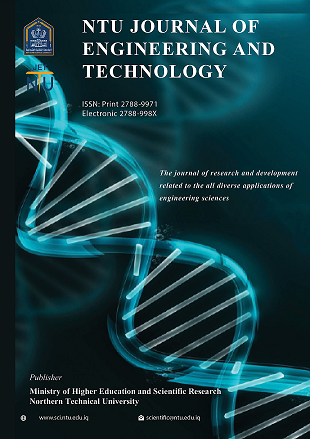Performance Evaluation of a Low Energy Universal Gate for VLSI with 16nm Technology
DOI:
https://doi.org/10.56286/ntujet.v1i3.209Keywords:
gate, VSLI, NAND, CMOS, DELAY, LOGICAbstract
NAND & NOR logic gates are general purpose logic gates that can be used to build other logic gates. This article describes a new NAND gate based on 3T (3 transistors) which has the correct output logic level and behaves similarly to the previous design NAND gate logic. The proposed structure has faster processing and lower power consumptionwhat makes it ideal for large-scale integration (VLSI) applications. Typical 16nm CMOS fabrication techniques were used for simulation, building Nand Gate, and to compare it to Nand Gate with different techniques and design such as using four transistors. It turns out that the amount of delay in this desgin with the selected technology compared to other projects with other technologies is less, that is, 0.02966 ns, which proves that the smaller the delay, the faster the gate operates.
References
Geetha Priya M. and Baskaran K., “A Novel Low Power 3 Transistor based Universal Gate for
VLSI Applications”, Journal of Scientific & Industrial Research, Vol. 72, pp.217-221, 2013
M. Geetha Priya, K. Baskaran, D. Krishnaveni and S. Srinivasan, "A New Leakage Power
Reduction Technique for CMOS VLSI Circuits”, Journal of Artificial Intelligence, Vol. 5, pp.
-232, 2012.
K. Baskaran et al., “Leakage Power Reduction Techniques in Deep Submicron Technologies
for VLSI Applications”, The International Conference on Communication Technology and
System Design, pp.1163 – 1170, 2011.
D.Krishnaveni et al., “A Novel Leakage Power Reduction Technique for CMOS VLSI Circuits”,
European Journal of Scientific Research,Vol.74, pp. 96-105, 2012.
Franco Maloberti, Analog Design for CMOS VLSI Systems.Kluwer Academic Publishers, 2001.
K. Roy, S. Mukhopadhyay, and H. Mahmoodi-Meimand, "Leakage current mechanisms and
leakage reduction techniques in deep-submicron CMOS circuits," Proeedings of the IEEE,
Feb. 2003, 91, (2), pp. 305-327.), pp305-327.
Priya, M.Geetha, Baskaran, K and Sriivasan, S., “PTL/CMOS Logic based Full Adder for High
Speed Applications,”Inter J of Advanced Computing, 35 (2012) 84-87.
CHEN Guo-zhang, "Study and Evaluation in CMOS Full Adder", Transaction of Tianjin
University, Tianjin, Vol.9 No.1, pp. 54-57, Mar. 2003.
Yip, K and Al-Khalil, D., “Multilevel logic synthesis using hybrid pass logic and CMOS
topologies,” IEE Proc Circuits, Devices and Systems, 150 (2003) 445–452.
G.L.Madhumati, M.Madhavilatha, and K.Ramakoteswara Rao, "Power and Delay Analysis of
a 2-to-1 Multiplexer Implemented in Multiple Logic Styles for Multiplexer- Based Decoder
in Flash ADC", International Journal of Recent Trends in Engineering, Vol. 1, No. 4, May
, pp.29-31.
Oleg Semenov, Hossein Sarbishaei and Manoj Sachdev, ESD rotection Device and Circuit
Design for Advanced CMOS Technol, New York: Springer, 2008.











